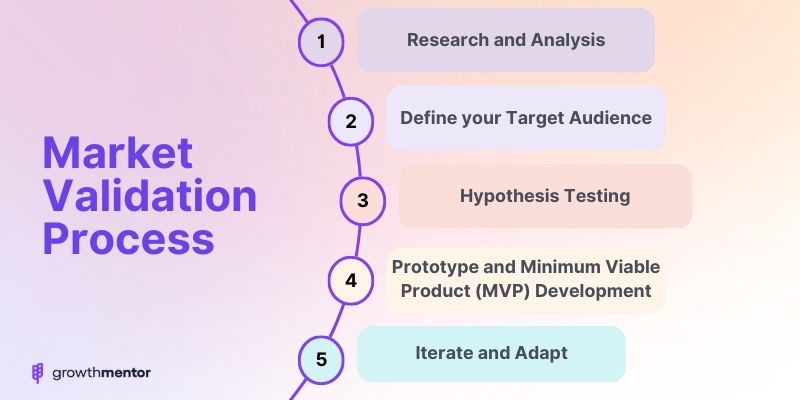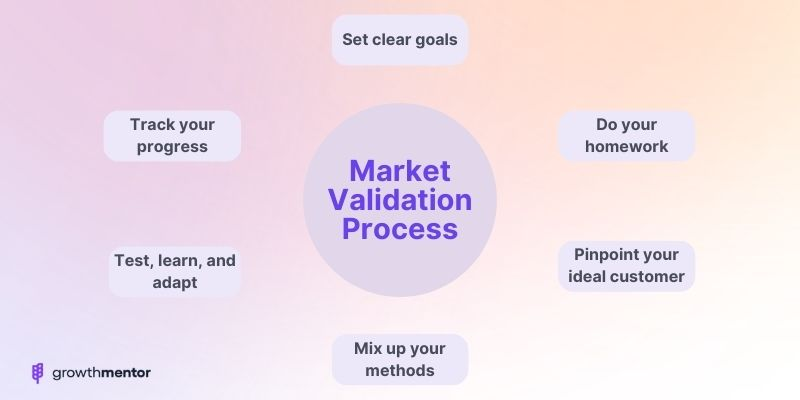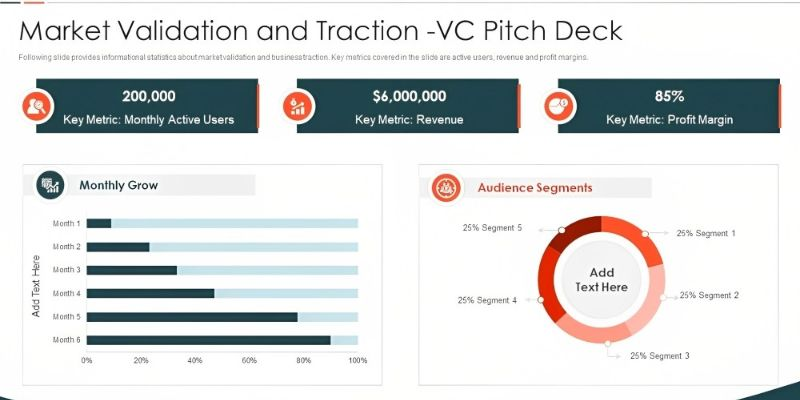Are you a business owner or an entrepreneur with a great product idea?
That’s fantastic!
But hold on, have you given any attention to the market viability of your product?
Knowing whether there is a market for it is just as important as having a fantastic idea. Market validation has a role in this.
How can you determine whether a market exists for your product? Who could be your future clients? What are their preferences and needs?
We’ll address these and other issues, as well as demonstrate how market validation can improve your chances of success.
Why market validation matters

Market validation enables businesses to stay on the right path, optimize resources, and avoid costly mistakes.
Let’s explore the key reasons why a market validation plan is a must for startups and businesses alike:
Identifying genuine demand
Market validation is crucial for startups and businesses because it helps figure out if there’s actual demand for a product or service. It’s a way to see if you’re on track before investing tons of resources.
Informed decision-making
By examining customer needs, market validation enables businesses to make smarter choices. This process uncovers market gaps and areas for improvement, leading to higher customer satisfaction and loyalty.
Effective resource allocation
Market validation supports prioritizing development and marketing efforts. Understanding the market’s needs helps maximize ROI and can even lead to strategic partnerships with other market players for mutual benefits.
Avoiding risks
Skipping market validation can be risky. You might launch a product that doesn’t resonate with your audience, wasting resources, causing financial losses, and damaging your reputation. Plus, you risk missing out on growth opportunities and overlooking competitors.
When should market validation be done?
Market validation means presenting a product concept to the target market that teaches the potential purchasers whether it is worth trying out.
This typically happens during a development period early on and does not involve substantial investment to develop the prototype version or product itself.
Market validation process
The time has come! Let’s delve into the core aspects of this valuable process.
Follow the step-by-step process to start finding your product market fit and validating your new or startup idea:

- Target market research and analysis: First, it’s essential to conduct thorough research on your target market. This involves gathering data on customer needs, preferences, and pain points. By examining existing market trends, industry reports, and competitor activities, you’ll gain a comprehensive understanding of the market landscape.
- Define your target audience: Next, pinpoint your target audience by identifying their demographics, psychographics, and behaviors. This will allow you to create customer personas crucial for tailoring your product or service to meet the specific needs and wants of prospective customers.
- Hypothesis testing: Formulate hypotheses about your product or service’s unique value proposition, pricing, and target audience. Then, test these assumptions through surveys, customer interviews, or focus groups. This step helps validate your offering’s relevance and appeal to potential customers.
- Prototype and Minimum Viable Product (MVP) development: Develop a prototype or MVP that reflects your product’s core features. This early version enables you to gather real-world user feedback, allowing you to refine and improve your offering.
- Iterate and adapt: Based on qualitative data and on the feedback and insights gained from earlier steps, make necessary adjustments to your product or service. Keep iterating and refining your offering to ensure it continually meets your target audience’s evolving needs and preferences.
Market validation methodologies
Market validation methods are diverse and can be tailored to your specific product or service.
Here are some common market validation methods to consider when validating your market:
- Surveys: Create online or in-person surveys to gather quantitative data from a large sample of your target audience.
- Interviews: Conduct one-on-one interviews to obtain in-depth qualitative insights and understand the pain points and preferences of potential customers.
- Focus Groups: Organize small group discussions to encourage conversation and obtain diverse opinions on your product or service concept.
- Observational Research: Monitor user behavior and interactions with your product or service in real-world settings to identify potential improvements.
- Prototyping: Develop a prototype or mock-up of your product to collect hands-on feedback from potential users, allowing you to make necessary adjustments.
- Minimum Viable Product (MVP): Launch a simplified version of your product or service to a limited audience, gather real-world feedback, and iterate based on the findings.
Market validation research common mistakes

We understand that founders and entrepreneurs can be quite eager when delving into research for their companies and products.
However, it’s important to remain vigilant, as this enthusiasm can sometimes lead to a few common mistakes that could throw a wrench in your plans.
We prepared a list of some pitfalls you should steer clear of:
- Skimping on research: Don’t cut corners on market research! Make sure you truly understand your customers and competitors. Dig deep into industry trends and data to get the full picture.
- The friends-and-family trap: While your loved ones might have opinions, they may not be the most objective or representative of your target customers or market. Reach out to a diverse range of potential customers to get the most accurate insights.
- Brushing off negative feedback: No one likes criticism, but don’t ignore it! Embrace negative feedback as a chance to improve your product or service. It’s like a free cheat sheet for success!
- Underestimating competitors: Keep an eye on your competition and stay in the know about what they’re up to. Knowing their moves helps you innovate and stand out in the crowd.
- Sticking to the script: Be ready to roll with the punches! Adapt and make changes based on the feedback you receive. Flexibility is your friend when it comes to your market validation processes. A product manager should be careful when it comes to updating prioritization. Make sure to focus on the changes potential “super user” will mention.
- Racing through the process: Slow and steady wins the race. Market validation isn’t a sprint, so don’t rush through it. Take the time to test and refine your offering for the best possible results.
Best practices for market validation
So, you’re ready to tackle market validation like a pro.
To help you on your journey, here are some best practices that’ll keep you on track:

Set clear goals
Before you dive in, outline your market validation objectives. Knowing your goals helps you stay focused and ensures that your research remains relevant and targeted.
Do your homework
Dig into your target market, competitors, and industry trends. Don’t be afraid to get your hands dirty with data, as this knowledge will empower you to make informed decisions.
Pinpoint your ideal customer
Create detailed customer personas by identifying their demographics, psychographics, and behaviors. This info will help you tailor your product or service to meet their specific needs and wants.
Mix up your methods
Don’t just rely on one research method. Combine surveys, customer interviews, focus groups, and other approaches to gather diverse insights that’ll give you a well-rounded and deeper understanding of your market.
Test, learn, and adapt
Embrace an iterative mindset. Use your findings to refine your own product concept or service, and don’t be afraid to pivot based on feedback. Remember, the market validation process is all about learning and adapting.
Track your progress
Monitor your progress and keep track of how well you’re meeting your market validation objectives. This way, you’ll stay accountable and motivated to keep pushing forward.
Market validation stakeholders
In the market validation process, involving the right people can make a significant difference in obtaining valuable insights and driving success.
Here’s a list of key stakeholders you should consider involving:
- Product/Service Development Team: Designers, engineers, or developers who can provide input on product features and functionality, and make necessary adjustments based on feedback.
- Marketing Team: Marketers who can help identify target audiences, craft effective messaging, and strategize on marketing channels to reach potential customers.
- Sales Team: Sales professionals who understand customer pain points and can contribute insights on pricing, packaging, and potential objections.
- Customer Support Team: Support staff who can offer insights into common customer issues, helping you address potential problems before they arise.
- Company Leadership: Founders, executives, or managers who can guide the overall direction of the product or service and make critical decisions during the validation process.
- External Participants: Potential customers, industry experts, or consultants who can provide objective feedback on your product or service, ensuring you gather diverse perspectives.
By involving a mix of internal and external stakeholders, you’ll be better equipped to navigate the market validation process and optimize your product or service for success.
Market validation examples
Let’s take a quick look at some market validation examples that’ll give you a feel for how it all comes together.
Ride-sharing apps
Before Uber and Lyft became household names, they needed to validate the demand for affordable, on-demand transportation. They gathered feedback from potential users, identified pain points in traditional taxi services, and tested their apps in select cities to ensure success.
Subscription boxes
Companies like Birchbox and Blue Apron tapped into the subscription-based business model by first validating product ideas in the market. They assessed customers’ interest in curated products or meal kits delivered to their doorstep, tested different pricing strategies, and iterated on their offerings based on user feedback.
Smart home devices
Before companies like Google and Amazon made smart home devices like Google Home and Amazon Echo popular, they first needed to validate the demand for voice-activated assistants and smart home integration. They researched consumer interest in home automation, identified pain points in managing multiple devices, and tested prototypes with select user groups. By gathering feedback and iterating on their designs, they successfully launched products that have now become a staple in many households.
Market validation and startup pitch deck
Market validation not only supports your company’s product and marketing efforts but can be an ally when it comes to pitching to investors.
Why?
Investors love seeing evidence that your product or service has a real shot at success.
A market validation plan shows them that you’ve done your homework, assessed demand, and learned from your target audience.

How?
- Share the idea validation process: Briefly explain the steps you took for market validation—research, interviews, surveys, etc.
- Highlight key findings: Showcase the most important insights that prove there’s a market for your offering.
- Demonstrate traction: If you’ve already gained some users or some paying customers, flaunt those numbers to reinforce your validation efforts.
- Show adaptability: Mention any pivots or iterations you’ve made based on feedback, proving you’re responsive to the market’s needs.
Final thoughts
Market validation is the key to unlocking your product’s potential.
It helps you understand your target audience, fine-tune your offering, and avoid costly missteps.
So, why not give it a go?
Take the leap and incorporate these market validation methods into the early stage of your product development process.
Trust us, your future self (and your business) will thank you for it.
Go ahead and embark on this journey toward a thriving, customer-approved product.
You’ve got this!
Frequently Asked Questions
Market validation is the process of testing a product or service’s viability by assessing its potential customers and market demand, ensuring it meets their needs and preferences.
It helps identify genuine demand, optimize resources, and inform decision-making, ultimately reducing risks and increasing the likelihood of success for your product or service.
Begin by researching your target market, analyzing industry trends, and examining competitor activities. Then, define your target audience and create customer personas.
Popular methods include surveys, interviews, focus groups, prototyping, and launching a minimum viable product (MVP) to gather real-world feedback.
Ensure thorough research, gather diverse feedback, pay attention to negative feedback, stay informed about competitors, be adaptable, and don’t rush the process.
Briefly explain the validation process, highlight key findings, demonstrate traction, and showcase any pivots or iterations made based on feedback.




